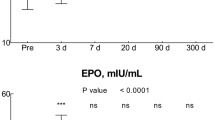Abstract
The effect of short-term exposure of three mouse-strains to simulated high altitude (SHA) of approximately 6,000m was studied. Subjecting C57BL/6J, DBA/2J or albino mouse strains to SHA for 39 days, occurring on alternating days, increased liver weight in the albino mouse compared to controls. The C57BL strain showed increased growth during SHA compared to other mouse strains. Morbidity score was greater in the albino mouse than in DBA mouse with no death occurring in C57BL mice exposed to SHA. Hepatic alcohol dehydrogenase was induced and mitochondrial aldehyde dehydrogenase was inhibited from corresponding controls subsequent SHA exposure by the C57BL and by the DBA mouse strain, respectively. The onset of ethanol-mediated narcosis was decreased from controls subsequent 21 days of SHA exposure by the DBA and by the albino mouse strain. The central depressant action of ethanol, as measured by the duration of ethanol-narcosis, was decreased in the C57BL mice exposed to SHA for 8, 21, or 35 days compared to controls. No apparent changes occurred in duration of ethanol-narcosis in the other mouse strains. The results suggest strain-difference in response to hypobaric conditions.
Similar content being viewed by others
References
Alkana RL, Syapin PJ (1979) Antagonism of ethanol narcosis in mice by low level hyperbaric treatment with pure oxygen. Curr Alcohol 5: 165–171
Bennett PB, Simon S, Katz Y (1975) High pressure of inert gases and anesthesia mechanisms. Prog Anesthesiol 1: 367–373
Blair AH, Vallee BL (1966) Some catalytic properties of human liver alcohol dehydrogenase. Biochemistry 5: 2026–2034
Blair AH, Bodly FH (1969) Human liver aldehyde dehydrogenase: Partial purification and properties. Can J Biochem 47: 265–272
Collins WE (1980) Performance effects of alcohol intoxication and hangover at ground level and at simulated altitude. Aviat Space Environ Med 51: 327–335
Dietrich RA (1979) Introduction to altering ethanol's effects. Curr Alcohol 5: 163–164
Fahim MS, Messiha FS, Girgis SM (1980) Effect of acute and chronic simulated high altitude on male reproduction and testosterone level. Arch Androl 4: 217–219
Fleming R, Reynolds D (1935) Experimental studies in alcoholism: IV. Attempts to modify the concentration of alcohol in the blood after intravenous administration of alcohol. J Pharmacol Exp Ther 54: 236–245
Fuller JL, Collins RL (1972) Ethanol consumption and preference in mice: A genetic analysis. Ann NY Acad Sci 197: 42–48
Higgins EA, Vaughan JA, Gordon E, Funkhauser E (1970) Blood alcohol concentrations as affected by combination of alcoholic beverage dosages and altitude. Aerospace Med 41: 1129–1132
McClearn GE, Rodgers DA (1959) Differences in alcohol preference among inbred strains of mice. Q J Stud Alc 20: 691–695
McDowell DG (1969) Biochemistry of hypoxia: Current concepts. II Biochemical derangements associated with hypoxia and their measurements. Br J Anaesth 41: 251–256
Merrit JH, Medina M (1968) Altitude induced alteration in drug action and metabolism. Life Sci 7: 1163–1169
Messiha FS (1980) Biochemical and experimental variance in ethanol-narcosis and preference studies. Adv Neurotoxicol 1: 127–135
Messiha FS, Hughes MJ (1979) Liver alcohol and aldehyde dehydrogenase: Inhibition and potentiation by histamine agonists and antagonists. Clin Exp Pharmacol Physiol 6: 281–292
Messiha FS, Morgan M, Geller I (1975) Ethanol narcosis in mice: Effects of levodopa, its metabolites and other experimental variables. Pharmacology 13: 340–351
Nettles JL, Olson RN (1965) Effects of alcohol on hypoxia. JAMA 194: 135–136
Reed R, Pace N (1980) Energy status and oxidation-reduction status in rat liver at high altitude (3.8 Km). Aviat Space Environ Med 51: 448–453
Rodgers DA, McClearn GE (1962) Mouse strain differences in preference for various concentration of alcohol. Q J Stud Alc 23: 26–33
Sheppard JR, Albersheim P, McClearn G (1970) Aldehyde dehydrogenase and ethanol preference in mice. J Biol Chem 245: 2876–2882
Will DH, Hicks JL, Card CS, Alexander AF (1970) Genetic basis for high altitude adaptation in Cattle. Fed Proc 29: 591
Wilson EC, Respess JC, Hollifield C, Parson W (1961) Studies of alcohol metabolism in mice which preferentially consume ethanol. Gastroenterology 409: 807–808
Zapata-Ortiz V, Battall L, Gonzales I (1969) Metabolismo del alcohol en las grandes alturas. Arch Biol Med Exp 3: 55–58
Author information
Authors and Affiliations
Rights and permissions
About this article
Cite this article
Messiha, F.S. Ethanol and simulated high altitude. Arch Toxicol 50, 77–83 (1982). https://doi.org/10.1007/BF00569239
Received:
Issue Date:
DOI: https://doi.org/10.1007/BF00569239



